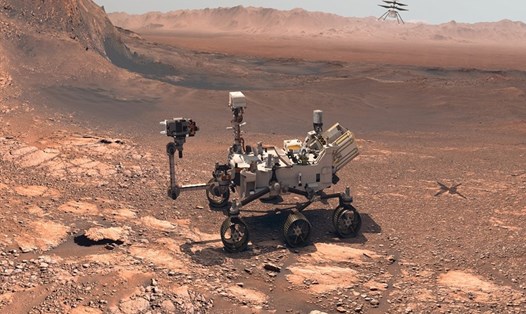Snow falls on Mars
In addition to the beautiful photos showing the thick layer of ice at Mars' poles, it is difficult to imagine snow falling on the red planet. But in 2008, NASA's Phoenix Lander discovered snow falling on Mars.
Using data from the Phoenix Lander, as well as Mars Reconnaissance Orbiter, Arizona State University graduate student Aditya Khuller and his colleagues determined that snow and ice look slightly different on Mars.
When snow forms on Mars, dust is one of the components, making it look more like the dirty snow we see on Earth. And once the snow falls, it is covered in Martian dust. These combined factors make ice and snow on Mars not only dusty but also much darker than the fresh snow on Earth. The study was published on August 18 in the Journal of "geophysical Research: Planets" of the American Geophysical Society.
The research also raised an attractive idea. Dust could heat up this layer of ice and snow, which could melt into the surface of Mars - where there is the possibility of microorganisms, protected from harsh, cold radioactive surfaces.
It is possible that this black, dusty layer of ice could melt into a few sentences, said Khuller. And any liquid water under the surface created by melting will be protected from evaporation in Mars' soft atmosphere by the layer of ice covering it.Khullers research on the melting of the ice layer is underway, and it could reveal more about Mars climate history. The more scientists learn about the mysterious past of the climate on Mars, the more they realize that the planet may have gone through many ice ages.
Khuller's previous research has discovered ice and dust at the average latitude of Mars, which could form ditches and mountain cracks near the equator.
Khuller said that if snow or ice is truly melted, it could flow into these ditches.
Understanding the potential location of liquid mines on Mars, which could happen if this layer of ice melts in the summer on Mars, could provide water that future explorers can access.
Establishing a Mars weather modelMeanwhile, Aymeric Spiga, a researcher at the Laboratoire de Meteorologie Dynamique meteorological lab in Paris, wants to take observations from the Phoenix Lander and apply his expertise in building a digital model of the red planet atmosphere to reveal more about the weather on Mars that we cannot see.
I want to explore the physical element behind the behavior of clouds and weather on planets beyond Earth, said Spiga. I felt like an extra-terrestrial weather forecaster. Why, and how, does snow fall on Mars? And why don't there be more evidence for it?"
According to Spiga's research published in the journal Nature Geoscience, on Mars day, cloud particles absorb visible light to warm the atmosphere. But at night, in areas with conditions suitable for the formation of water clouds, it can lead to frost.
By combining computer models and observations of landing ships, Spiga and his colleagues found that the night phenomenon led to super-small outbreaks of snowstorms, some of which could last for hours.
So why haven't rover taken a picture of the heavily packed snow on Mars' surface yet? In the case of snow discovered by the Phoenix Lander, the snow had evaporated before touching land.
Some snowstorms may be too high in the atmosphere for snow to fall to the surface, wrote Spiga. But one thing is for sure: The amount of ice accumulated on the surface will be much smaller than on Earth, and in some regions, this ice layer will flourish immediately the next morning. Therefore, there are no snowmen or ski stations on Mars!
In the future, Spiga and his colleagues want to explore the diversity of possible snowstorms on Mars and how they will impact the water cycle on Mars. This could also help them look back at Mars' past and the history of its ice fields.
Since the ice clouds on Mars create strong winds, our research could also be used to design grounding and flight systems in Mars atmosphere, Spiga wrote.




